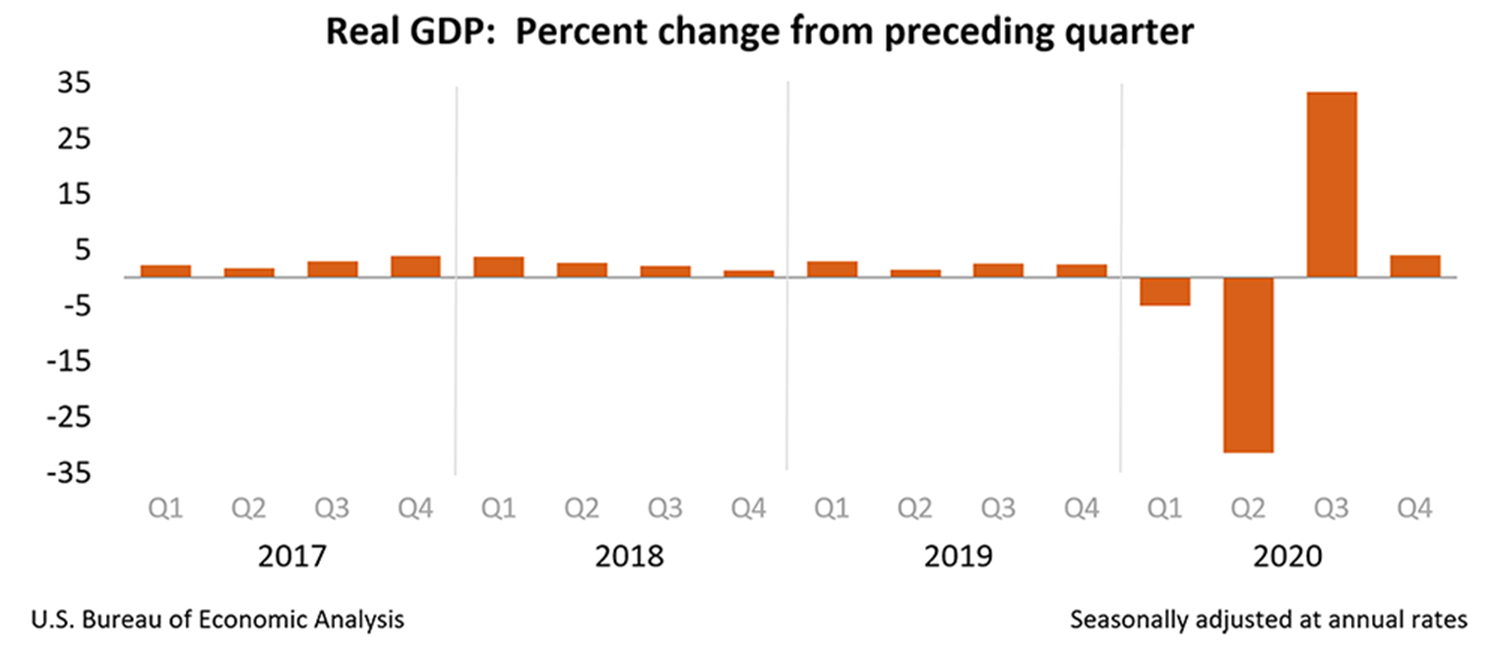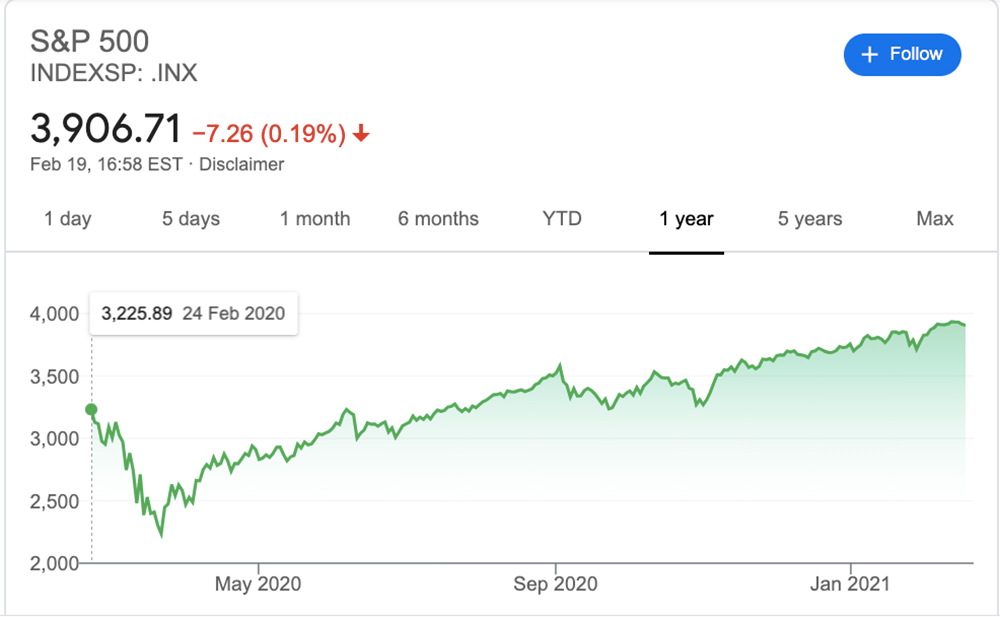去年,正是在這一周,,美國(guó)股市似乎得到了首個(gè)暗示:新冠疫情可能會(huì)帶來重大影響,。
當(dāng)時(shí)股市并未出現(xiàn)自由落體式下跌,但各種麻煩卻在去年的這一周接踵而至,。LPL Financial的首席市場(chǎng)策略師萊恩?德特里克寫道:“市場(chǎng)上有一句老話:‘股市上漲像爬樓梯,,下跌像坐電梯?!蔀榱私酉聛韼字苤泄墒械恼鎸?shí)寫照,。”
在1月底之前,,盡管有少數(shù)頭條在報(bào)道中國(guó)的新冠疫情,,但市場(chǎng)觀察家依然認(rèn)為新冠病毒不會(huì)對(duì)股市造成多大的影響。直到2月19日,,一則新聞才真正引起了市場(chǎng)的關(guān)注:“中國(guó)將盡一切努力來緩沖新冠疫情的影響,,而且會(huì)視情況采取刺激舉措?!?/p>
兩天后,,也就是2月21日,展望突然發(fā)生了巨大變化,。有報(bào)道稱,,日本、韓國(guó)和澳大利亞出現(xiàn)了大量的新冠病例,。當(dāng)天,,高盛(Goldman Sachs)的皮特?奧本海默在一則紀(jì)要中向投資者發(fā)出警告,股市進(jìn)行修正的“可能性更大了”,。
到了第二周的周一,,意大利的病例出現(xiàn)激增,美國(guó)則在緩慢上升,,股市終于開始認(rèn)真對(duì)待這件事情,?!敦?cái)富》雜志的高級(jí)編輯伯納德?華納寫道:“所有的指標(biāo)顯示,就算這不是自新冠疫情最初于1月中旬爆發(fā)以來最差的交易時(shí)期,,也算是最差之一了,。與此掛鉤的道瓊斯指數(shù)和標(biāo)普500指數(shù)(S&P 500)在開盤后便下跌了約2%?!?/p>
很快,,股市的自由落體開始了。德特里克在其報(bào)告中寫道,,到當(dāng)月月底,,“標(biāo)普500指數(shù)迎來了歷史上最快的熊市(收盤時(shí)較此前的歷史新高下滑了20%),而且僅用16天便完成了這一壯舉,?!?/p>
盡管當(dāng)時(shí)在任的唐納德?特朗普總統(tǒng)依然稱新冠病毒對(duì)大多數(shù)美國(guó)人來說屬于低風(fēng)險(xiǎn)事件,但市場(chǎng)已經(jīng)處于高度警惕狀態(tài),。2月28日,,華納稱:“美元下跌,原油下跌,,大宗商品再次暴跌,。即便是黃金也出現(xiàn)了拋售現(xiàn)象。很明顯,,牛市正在消退,。”
這還只是個(gè)開始,。在市場(chǎng)暴跌期間,,全球的經(jīng)濟(jì)學(xué)家擔(dān)心情況會(huì)變得一發(fā)不可收拾,有一些人甚至預(yù)測(cè)會(huì)出現(xiàn)另一場(chǎng)經(jīng)濟(jì)大蕭條,。
Commonwealth Financial Network的資產(chǎn)組合負(fù)責(zé)人皮特?艾瑟拉說:“經(jīng)濟(jì)學(xué)家預(yù)測(cè),,全球會(huì)出現(xiàn)貿(mào)易暫停,大規(guī)模的封鎖,,而且認(rèn)為這將是一個(gè)持續(xù)數(shù)月,、數(shù)個(gè)季度,甚至可能是數(shù)年的夢(mèng)魘,?!?/p>
一年后,超過50萬美國(guó)人死于新冠病毒,,這個(gè)數(shù)字已經(jīng)高于亞特蘭大的人口數(shù)量,。此外,美國(guó)暴力案件數(shù)量呈上升趨勢(shì),,因?yàn)槌掷m(xù)的阿片類藥物危機(jī)而導(dǎo)致的過量服藥案例出現(xiàn)了激增,,創(chuàng)紀(jì)錄的美國(guó)民眾因?yàn)?020年失業(yè)率的飆升而失去了醫(yī)療保險(xiǎn)。
然而事實(shí)證明,,有關(guān)經(jīng)濟(jì)最為悲觀的預(yù)測(cè)并未實(shí)現(xiàn),。在經(jīng)歷了紛亂的上半年之后,美國(guó)實(shí)際GDP在2020年第三季度增長(zhǎng)了33.4%,。美國(guó)經(jīng)濟(jì)分析局(U.S. Bureau of Economic Analysis)的數(shù)字顯示,,這一增長(zhǎng)延續(xù)到了第四季度,當(dāng)時(shí)美國(guó)的實(shí)際GDP再次增長(zhǎng)了4%,。

到了8月18日,,標(biāo)普500指數(shù)再創(chuàng)歷史新高,,而且自此之后一路高歌。
德特里克在報(bào)告中寫道:“股市有著十分奇怪的機(jī)制,?!?/p>

LPL Financial稱,對(duì)日常生活回歸常態(tài)化的預(yù)期已經(jīng)開始決定股市的定價(jià),,不過,,生活何時(shí)完全回歸正常依然是個(gè)未知數(shù)。
德特里克寫道:“相對(duì)于新冠疫情初期,,全球經(jīng)濟(jì)環(huán)境一直在不斷改善,。盡管依然存在諸多弱點(diǎn),但市場(chǎng)更擔(dān)心的是經(jīng)濟(jì)今后的走向,,而不是其當(dāng)前的狀況,。”(財(cái)富中文網(wǎng))
譯者:馮豐
審校:夏林
去年,,正是在這一周,,美國(guó)股市似乎得到了首個(gè)暗示:新冠疫情可能會(huì)帶來重大影響。
當(dāng)時(shí)股市并未出現(xiàn)自由落體式下跌,,但各種麻煩卻在去年的這一周接踵而至,。LPL Financial的首席市場(chǎng)策略師萊恩?德特里克寫道:“市場(chǎng)上有一句老話:‘股市上漲像爬樓梯,下跌像坐電梯,?!蔀榱私酉聛韼字苤泄墒械恼鎸?shí)寫照?!?/p>
在1月底之前,,盡管有少數(shù)頭條在報(bào)道中國(guó)的新冠疫情,但市場(chǎng)觀察家依然認(rèn)為新冠病毒不會(huì)對(duì)股市造成多大的影響。直到2月19日,,一則新聞才真正引起了市場(chǎng)的關(guān)注:“中國(guó)將盡一切努力來緩沖新冠疫情的影響,,而且會(huì)視情況采取刺激舉措?!?/p>
兩天后,,也就是2月21日,展望突然發(fā)生了巨大變化,。有報(bào)道稱,,日本、韓國(guó)和澳大利亞出現(xiàn)了大量的新冠病例,。當(dāng)天,,高盛(Goldman Sachs)的皮特?奧本海默在一則紀(jì)要中向投資者發(fā)出警告,股市進(jìn)行修正的“可能性更大了”,。
到了第二周的周一,,意大利的病例出現(xiàn)激增,美國(guó)則在緩慢上升,,股市終于開始認(rèn)真對(duì)待這件事情,。《財(cái)富》雜志的高級(jí)編輯伯納德?華納寫道:“所有的指標(biāo)顯示,,就算這不是自新冠疫情最初于1月中旬爆發(fā)以來最差的交易時(shí)期,,也算是最差之一了。與此掛鉤的道瓊斯指數(shù)和標(biāo)普500指數(shù)(S&P 500)在開盤后便下跌了約2%,?!?/p>
很快,股市的自由落體開始了,。德特里克在其報(bào)告中寫道,,到當(dāng)月月底,“標(biāo)普500指數(shù)迎來了歷史上最快的熊市(收盤時(shí)較此前的歷史新高下滑了20%),,而且僅用16天便完成了這一壯舉,。”
盡管當(dāng)時(shí)在任的唐納德?特朗普總統(tǒng)依然稱新冠病毒對(duì)大多數(shù)美國(guó)人來說屬于低風(fēng)險(xiǎn)事件,,但市場(chǎng)已經(jīng)處于高度警惕狀態(tài),。2月28日,華納稱:“美元下跌,,原油下跌,,大宗商品再次暴跌。即便是黃金也出現(xiàn)了拋售現(xiàn)象,。很明顯,,牛市正在消退。”
這還只是個(gè)開始,。在市場(chǎng)暴跌期間,,全球的經(jīng)濟(jì)學(xué)家擔(dān)心情況會(huì)變得一發(fā)不可收拾,有一些人甚至預(yù)測(cè)會(huì)出現(xiàn)另一場(chǎng)經(jīng)濟(jì)大蕭條,。
Commonwealth Financial Network的資產(chǎn)組合負(fù)責(zé)人皮特?艾瑟拉說:“經(jīng)濟(jì)學(xué)家預(yù)測(cè),,全球會(huì)出現(xiàn)貿(mào)易暫停,大規(guī)模的封鎖,,而且認(rèn)為這將是一個(gè)持續(xù)數(shù)月、數(shù)個(gè)季度,,甚至可能是數(shù)年的夢(mèng)魘,。”
一年后,,超過50萬美國(guó)人死于新冠病毒,,這個(gè)數(shù)字已經(jīng)高于亞特蘭大的人口數(shù)量。此外,,美國(guó)暴力案件數(shù)量呈上升趨勢(shì),,因?yàn)槌掷m(xù)的阿片類藥物危機(jī)而導(dǎo)致的過量服藥案例出現(xiàn)了激增,創(chuàng)紀(jì)錄的美國(guó)民眾因?yàn)?020年失業(yè)率的飆升而失去了醫(yī)療保險(xiǎn),。
然而事實(shí)證明,,有關(guān)經(jīng)濟(jì)最為悲觀的預(yù)測(cè)并未實(shí)現(xiàn)。在經(jīng)歷了紛亂的上半年之后,,美國(guó)實(shí)際GDP在2020年第三季度增長(zhǎng)了33.4%,。美國(guó)經(jīng)濟(jì)分析局(U.S. Bureau of Economic Analysis)的數(shù)字顯示,這一增長(zhǎng)延續(xù)到了第四季度,,當(dāng)時(shí)美國(guó)的實(shí)際GDP再次增長(zhǎng)了4%,。
到了8月18日,標(biāo)普500指數(shù)再創(chuàng)歷史新高,,而且自此之后一路高歌,。
德特里克在報(bào)告中寫道:“股市有著十分奇怪的機(jī)制?!?/p>
標(biāo)普500指數(shù)
LPL Financial稱,,對(duì)日常生活回歸常態(tài)化的預(yù)期已經(jīng)開始決定股市的定價(jià),不過,,生活何時(shí)完全回歸正常依然是個(gè)未知數(shù),。
德特里克寫道:“相對(duì)于新冠疫情初期,全球經(jīng)濟(jì)環(huán)境一直在不斷改善,。盡管依然存在諸多弱點(diǎn),,但市場(chǎng)更擔(dān)心的是經(jīng)濟(jì)今后的走向,而不是其當(dāng)前的狀況?!保ㄘ?cái)富中文網(wǎng))
譯者:馮豐
審校:夏林
It was this week one year ago that the stock market seemed to get the first hint that COVID could be a thing.
It wasn’t a straight drop down, but this week one year ago marked the start of trouble. “The old market adage ‘Stairs up, elevator down’ certainly rang true over the coming weeks,” wrote Ryan Detrick, chief market strategist for LPL Financial, in a new report.
By the end of January, market-watchers were still guessing that the coronavirus would have little impact on the stock market despite a smattering of headlines about the virus spreading rampantly throughout China. As late as Feb. 19, markets were “climbing on the news that Beijing [would] likely do whatever it takes—injecting stimulus where needed—to cushion the coronavirus blow.”
Two days later, on Feb. 21, the outlook was suddenly far different. Coronavirus cases were reported in large numbers in Japan, South Korea, and Australia, signaling the end of any hope of containing the virus in China. That day, Goldman Sachs’s Peter Oppenheimer warned investors in a note that a stock market correction was “l(fā)ooking more probable.”
By the following Monday, cases were surging in Italy, slowly rising in the United States, and the market was finally beginning to take serious notice. As Fortune senior editor Bernhard Warner wrote in his daily Bull Sheet newsletter on Feb. 24: “All indicators are pointing to one of the worst—if not the worst—trading sessions since the coronavirus outbreak first emerged in mid-January, with the Dow and S&P 500 pegged to open down about 2%.”
Soon, the market was in free fall. By the end of the month, “the S&P 500 recorded the fastest bear market (closing 20% below a previous all-time high) in history, accomplishing that feat in a mere 16 days,” Detrick wrote in his report.
And while then-President Donald Trump was still describing the coronavirus as a low-risk affair for most Americans, markets were already on high alert. On Feb. 28, Warner’s Bull Sheet reported that “the dollar is down, crude is down, and commodities are slumping again. Even gold is selling off. The bulls clearly are in retreat.”
That was just the beginning. Amid the market plunge, economists around the world feared the worst, some even going so far as to predict another Great Depression.
“Economists were forecasting a global halt to trade, massive worldwide lockdowns, and were suggesting that it was going to be a multi-month, multi-quarter, and potentially even a multiyear nightmare scenario,” said Peter Essele, head of portfolio management for Commonwealth Financial Network.
A year later, more than 500,000 Americans have lost their lives to COVID-19, a number higher than the population of Atlanta. In addition, domestic violence numbers have risen, overdose numbers stemming from the ongoing opioid crisis are surging, and a record number of Americans were left without health insurance as unemployment soared in 2020.
But it turns out that the most dire predictions about the economy did not come to pass. After a tumultuous first half of the year, U.S. real GDP increased 33.4% in the third quarter of 2020. Those gains continued into the fourth quarter, when real GDP again rose by 4%, according to the U.S. Bureau of Economic Analysis.
And by Aug. 18, the S&P 500 set new all-time highs and hasn’t looked back since.
“The stock market is a peculiar mechanism,” Detrick wrote in the report.
The stock market has already priced in the normalization of daily life, even if the timeline for a complete return remains uncertain, according to LPL Financial.
“Economic conditions around the world have been improving relative to how they were at the beginning of the pandemic,” Detrick wrote. “While pockets of weakness remain, the market is more concerned with where the economic conditions will be, not where they are currently.”






